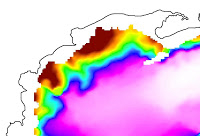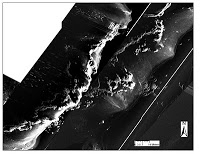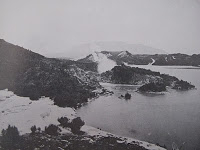Lake Rotomahana explored for famous buried terraces
Located at the centre of New Zealand's most violent and devastating eruption in 1886, shaken by volcanic earthquakes, covered by many meters of mud and ash and then flooded underneath a lake; it is little surprise that the world believed the pink and White Terraces to be destroyed and lost forever.
However despite all the odds, an area of New Zealand's iconic Pink Terraces of Rotomahana have been re-discovered.
Scientists involved in the Rotomahana Project announced their findings, 125 years after the Tarawera Eruption,thanks to the underwater vehicle and imaging technology and skills developed by the Wood's Hole Oceanographic Institution (WHOI).
A key component of the expedition was the use of the Remus100 autonomous underwater vehicles (AUVs) developed at WHOI.
Dr. Vicki Ferrini of LDEO observed the terrace formations as she was processing images from the sidescan sonar. After checking details like water depth, location, orientation, shape and size of the features, Cornel de Ronde and the rest of the scientific team reached the conclusion that these could only be, part of the original Pink Terraces last seen on June the 9th 1886.
A picture tells a thousand words
The features in the sonar image show up as curved step like surfaces and as bright reflectors.
They are comprised of a hard material and are therefore acoustically darker than the sediment that surrounds them. It is the steeply sloping or vertical sections that show up most brightly, probably because they are free from any overlying sediment.
With the aid of pre-eruption photographs, scientist were able to distinguish distinct features of the lake shoreline with very identifiable contours and hooked spits of land.
In the compiled bathymetric map produced by Vicki from the AUV survey data, the same hooked-shaped peninsular can be seen in the lake bed. This is in the northern section of Lake Rotomahana, in the area that has been indentified as the probable location of the Pink Terraces by previous researchers.
The close-up of the lake floor bathymetry shows this feature clearly (depths in the map are color coded - pink is deep and red is shallow).
The main cascade of the Pink Terraces would fit in the green embayment in the top centre of the image, and the wide lower part of the terraces should extend down roughly in the centre along the green or pale blue band.
When overlaid on top of the bathymetric map, Vicki's step like rock features lie exactly on top of this location.
What lies beneath?
This means that the lower portion of the Pink Terraces still remain. It is possible that they were covered in debris by the eruption and that subsequent water erosion has exposed their edges again.
The question still remains as to whether the upper section of the terraces are still intact underneath a layer of sediment. The sonar sensors used in this survey are unable to reveal enough subsurface detail to answer this, however, a future expedition using seismic reflection techniques could answer this question.
The last of the underwater photos, taken near the region identified as being where the strong reflectors of the Pink Terraces were located, show the vertical edge of a terrace head on.
These initial findings do leave additional questions to be answered, but for now, to know that a part of the Pink Terraces of Lake Rotomahana are still there, hidden in the depths of the water, leaves us with the excitement of possibility.
Are they fully intact and will they one day be restored to their former glory?











Connect with Us
Facebook YouTube Instagram Tripadvisor Blog Email